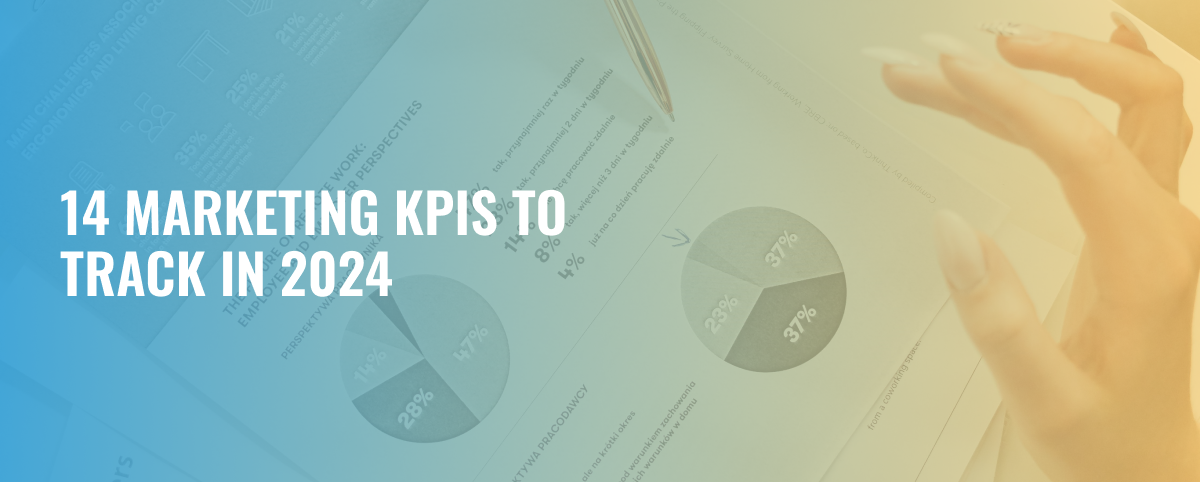8 minute read
14 MARKETING KPIS YOU NEED TO TRACK IN 2024
Marketing KPIs, or key performance indicators, are essential metrics for tracking the success of any marketing strategy. As the business landscape continues to evolve, it is critical to stay informed on these metrics to make informed decisions that drive growth and profitability.
By 2024, the marketing landscape is expected to be more competitive than ever, so it will be critical for businesses to track the right KPIs to stay ahead. In this article, we look at fourteen examples of marketing KPIs that every marketer should follow in 2024 to measure the effectiveness of their campaigns, analyze market trends, and make data-driven decisions for their business.
-
MARKETING ROI
Tracking marketing ROI will be more important than ever for businesses as competition continues to grow. For example, monitoring the conversion rate of website visitors to customers will provide valuable information about the effectiveness of a company’s marketing strategies. KPIs not only measure the effectiveness of marketing campaigns, but also help companies make data-driven decisions to increase ROI. By tracking marketing ROI in 2024, companies can stay ahead of the competition and ensure that their marketing efforts will yield profitable results.
-
COST PER LEAD
Cost per lead is expected to be a key KPI for enterprises by 2024, given the increasingly competitive market. This KPI calculates the amount of money a company spends to generate a single lead. It provides valuable information about the effectiveness of a company’s marketing activities and helps in allocating budgets. By tracking this KPI, companies can identify areas for improvement and make data-driven decisions to achieve their marketing goals.
-
TRAFFIC TO MQL (MARKETING QUALIFIED LEAD) RATIO
An important marketing KPI for 2024 is the ratio of traffic to MQL (Marketing Qualified Lead). It measures the effectiveness of a company’s marketing campaigns in driving traffic to its website and converting that traffic into qualified leads. By tracking this ratio, companies can determine the effectiveness of their marketing strategies and make changes to improve their lead generation efforts. This KPI provides valuable insight into the overall effectiveness of a company’s marketing efforts and is key to setting and achieving business goals.
-
SOCIAL MEDIA ENGAGEMENT
Social media engagement has become an essential aspect of marketing in today’s digital landscape. As consumers become more active on social media, businesses need to track their social media engagement to measure their performance. Some key examples of marketing KPIs to track social media engagement include reach, impressions, engagement rate, click-through rate, and follower growth. These metrics help businesses make strategic decisions to improve their online presence. Additionally, tracking this KPI can also help identify a brand’s strengths and weaknesses on social media, leading to targeted improvements for higher engagement in 2024.
-
CLICK-THROUGH RATE
Another important marketing KPI to track in 2024 is click-through rate (CTR). This metric measures the percentage of people who clicked on a specific link or ad, indicating their interest in the content or product. A high CTR indicates effective targeting and messaging, while a low CTR may indicate the need for optimization. Examples of marketing KPIs closely related to CTR are conversion rates, cost per click, and return on investment. Monitoring CTR along with other KPIs can provide a holistic view of campaign performance and guide future marketing strategies.
-
SEARCH ENGINE RANKINGS (WEB TRAFFIC)
An important marketing KPI to track in 2024 is search engine rankings and web traffic. This metric measures the success of a website in gaining visibility and attracting visitors through search engines. By tracking this KPI, businesses can measure the effectiveness of their SEO strategies and make necessary adjustments to improve their search engine performance. For example, if a company’s website ranks low on Google, the company may need to focus on optimizing its content and keywords to increase website traffic. This KPI can help businesses understand the overall effectiveness of their marketing and make informed decisions to achieve their goals.
-
BRAND AWARENESS
Brand awareness will remain a top priority for marketers in 2024, so it’s important to track the right KPIs. Some examples of marketing KPIs for measuring brand awareness include website traffic, social media engagement, and customer reviews. These metrics can provide valuable information about how well a brand is resonating with its target audience and whether its marketing efforts are effective in increasing visibility and recognition. By consistently tracking these KPIs, brands can better understand their impact and make informed decisions to improve their overall brand awareness strategy.
-
TRAFFIC DISTRIBUTION
Even more emphasis will be placed on monitoring and analyzing these KPIs, especially as it relates to traffic distribution. One of the most important marketing KPI examples in this category is website traffic, which indicates the number of visitors to your website. Other crucial KPIs to track include channel-specific traffic, such as social media or email marketing, as well as lead generation metrics, such as conversion rates and cost per lead. By monitoring these KPIs, businesses can gain valuable insights into their website traffic and make data-driven decisions to improve their marketing efforts.
-
CONVERSION RATE
Conversion rate is an essential marketing KPI that every business needs to track in 2024. It measures the effectiveness of converting website visitors into customers and is crucial for measuring the effectiveness of marketing campaigns. For example, a high conversion rate indicates that your marketing efforts are impacting your target audience and prompting them to take action. On the other hand, a low conversion rate may indicate communication or targeting problems. By tracking conversion rates, businesses can make informed decisions about their marketing strategies, optimize their efforts, and ultimately generate more sales.
-
IMPRESSION AND REACH
A key marketing KPI to track is impression and reach, which measures how many people were exposed to your brand’s message. By monitoring this, companies can better understand their brand awareness and reach within their target market. Some examples of other marketing KPIs that you should also track in 2024 include website traffic, lead generation, and customer acquisition. With these statistics in mind, companies can gain valuable insights and make informed decisions to improve their marketing strategies and ultimately drive growth.
-
CUSTOMER LIFETIME VALUE
One of the most important marketing KPI examples to track in 2024 is customer lifetime value (CLV). This KPI measures the total revenue a customer generates for your company over the entire relationship with you. Factors such as repeat purchases, average order value, and customer retention are taken into account. By tracking CLV, you can evaluate the profitability and loyalty of your customer base, identify which customers are most valuable, and adjust your marketing strategies accordingly. This KPI is especially important in 2024 as the market becomes increasingly competitive and companies must prioritize retaining and maximizing the value of their existing customers.
-
BACKING OUTREACH
Another key KPI that companies should focus on in 2024 is backing outreach. This metric assesses the effectiveness of outreach efforts in reaching potential customers and converting them into actual buyers. Examples of marketing KPIs related to backing outreach include click-through rate, conversion rate, and customer acquisition costs. By carefully tracking these KPIs, companies can optimize their outreach strategies and ultimately achieve higher returns on their marketing investments.
-
SHARE OF VOICE
Share of voice is a crucial metric for tracking the effectiveness of a marketing campaign. In 2024, it will remain a crucial KPI that companies need to monitor to understand their brand’s visibility and impact in the market. This metric measures the percentage of a brand’s online presence compared to its competitors. It can be calculated by analyzing website traffic, social media engagement, and search engine rankings. By tracking share of voice, companies can gain valuable insights into consumer behavior, identify opportunities for improvement, and make strategic decisions for their marketing efforts.
-
SOCIAL SHARES
Social shares refer to the number of times your content is shared on social media platforms like Facebook, Twitter, and LinkedIn. This metric is a good indicator of the reach and engagement of your marketing efforts. Tracking social shares can help you measure the effectiveness of your content and understand what resonates with your audience. It can also help you determine which platforms are most effective in reaching your target audience and guide your future marketing decisions. Some examples of social actions as marketing KPIs are retweets, likes, shares, and comments. By keeping a close eye on this KPI, you can ensure that your content reaches and resonates with your audience.
CONCLUSION
Tracking key performance indicators (KPIs) in marketing is crucial for companies that want to determine their success and identify areas for improvement. As the ever-changing digital marketing landscape continues to evolve, companies must adapt and track key KPIs. Some examples of important marketing KPIs to consider include website traffic, conversion rates, customer acquisition costs, and social media engagement. By consistently monitoring these metrics and making strategic adjustments, companies can achieve their marketing goals and, ultimately, overall success. With 2024 now on the horizon, it is critical for businesses to stay on top of their marketing KPIs and adapt to the changing environment to stay ahead of the competition.

